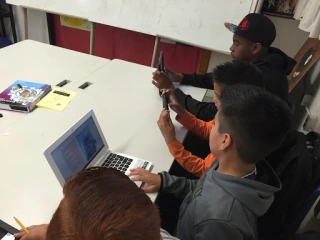With a Breakout EDU game using the box, setup instructions are provided. It gives the lock combinations, printable materials, and the paths the students follow to solve the riddles. You need these in order to facilitate the game. With the Breakout EDU Digital games, none of this is provided – everything is ready to go as soon as you enter the game.
Multiple times a week, we receive emails, tweets, Facebook messages, and other assorted communication from teachers asking for an answer key to the Digital games. When we receive these messages, we provide additional prompts and hints, but refuse to provide answer keys.
Why do we do this? Is it because we are evil and want you to suffer? Absolutely not – this is our contribution to the Breakout EDU mantra. For the bulk of the history of education, teachers have been viewed as the keepers of knowledge or the sage on the stage. In our opinion, this has gone on far too long. With the advent of the digital age, students have access to limitless amounts of information. Our roles as teachers need to change.
The “hidden curriculum” of soft skills is just as critical as the content we are mandated to teach. Words like rigor, growth mindset, resilience, and productive struggle thrown around as skills that students need to be successful in life, yet how often do we model this for our students? By not having access to an answer key, you are provided with a perfect opportunity to experience what a student feels when they first encounter a tough trigonometry problem. You’re faced with a choice – put in effort to stretch your abilities to their fullest extent and grow your brain or email us for an answer (which is akin to flipping to the back of the textbook for the key.) Which would you prefer your students to do? Why do we not hold ourselves to that same standard?
You don’t have to struggle alone – share your plight with your students. Challenge them to help you complete the puzzles. Students see things differently than adults; something that has stumped us for hours takes a matter of seconds for them. Imagine their moment of glorious success. They solved something their teacher couldn’t.
But it’s deeper than that. You were vulnerable with them. You shared your struggle. You modeled resiliency and a refuse to give up. You showed them that it’s ok to ask for help; that it’s ok to admit you don’t always have all the answers. This is a bond that can’t be forged by playing a video about famous figure who overcame adversity to reach success. They’ll be more likely to let down their guard and ask you for help – and you’ll understand their feelings even better.
 |
| Nicole Link couldn’t solve a clue when I introduced Breakout EDU to teachers at lunch, so she came back to play with my students on her prep period! |
By now you’re thinking that this is easy for us to say – we have all the answers to the games. However, we’ve played other’s games and been through this productive struggle.
And it’s not just us who feel this way. For every few requests for answers, there’s one praising this dedication to doing something differently. We’ll close with our favorite, which comes from Dr. Donovan DeBoer, superintendent of Parker School District in South Dakota:
“One of my “mantras” has always been: “The one that does the doing, does the learning.” So when I was ever so close to our first teacher in-service days, and [Breakout EDU Digital] was one of the items I wanted to show my staff, I was very torn when I sent that dreaded, “I need help email.” However, in true educator fashion, [Justin and Mari] did not oblige my begging of “cheats” to complete the task. Instead, I was sent a very subtle hint and encouragement to complete the task.
It was a great lesson for me as a leader of young people, and adults. It helped solidify my belief that if you want to learn, you have to do.
It also proved to me how important collaboration is for our students. I needed help, I didn’t necessarily want the answers, but I needed another brain (or 32). As I introduced the activity to my staff, I was short one lock code. In the essence of time, we worked in groups on the digital breakout “Stranded on the Island.” As time passed I witnessed adults, veteran teachers, cheer with excitement when they found a new clue, or figured out a code, and hide their answers to allow for others to feel the same thing when they found things on their own.
Few more hours went by, in-service over, but I was still plugging away. I had to complete this thing. That’s when the magic happened – one of my football coaches sent me a text. He had solicited a friend from hours away, that started working on it as well, and we finally cracked the mystery lock.
The power of collaboration is real. Shared suffering in the task, and then the jubilation we share in the accomplishment. Two heads are better than one, and three better than two. Students need that time together, to share, to bounce ideas off one another, to enjoy the struggle together.
More importantly, we have to have the patience to let learners learn. They need to make mistakes, they need to learn from them, they need to talk it out with other people to learn the other side of communication not talked about “listening” to one another. Then the “magic,” can happen.”





